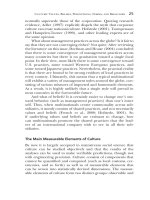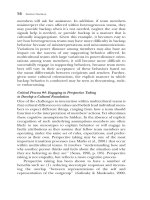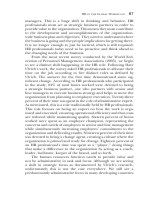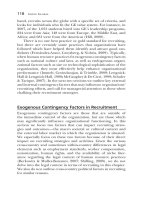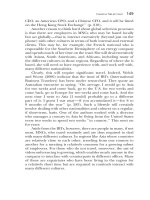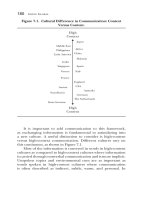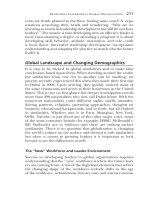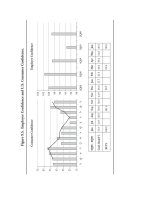Practical Applications and Recommendations for HR and OD Professionals in the Global Workplace J-B SIOP Professional Practice Series_9 potx
Bạn đang xem bản rút gọn của tài liệu. Xem và tải ngay bản đầy đủ của tài liệu tại đây (476.91 KB, 15 trang )
101-112 HBE-MCT C7 3rd 10/15/02 12:42 PM Page 112
This Page Intentionally Left Blank
appendix a
Useful Implementation Tools
This appendix contains four forms that you may find useful at
various times during a change initiative. All are adapted from Har-
vard ManageMentor
®
, an online help source for subscribers. For
interactive versions of these forms, please visit www.elearning.hbsp
.org/businesstools. Here’s a list of the diagnostic tests, checklists, and
worksheets found in this appendix:
1.
Self-Evaluation: Characteristics of Effective Leadership.–Use this
form to evaluate your own leadership capabilities. Change pro-
grams require leadership at all levels.
2.
Managing Stress Levels.–This checklist is a helpful tool for iden-
tifying and managing stress among the people you deal with.
3.
Focus and Synergy.–This checklist will help you identify obsta-
cles encountered in the change process. Use this form or some-
thing like it to keep your team focused on the most important
problems. For each obstacle to your team’s progress, list and
evaluate options for overcoming it.Also list any allies, additional
resources, or special training your team members will need in
order to collaborate most effectively on the chosen option.
4.
Gathering and Sharing Information.–This checklist can help
you in the all-important business of communicating, which
must be done regularly and through different channels during a
change initiative. Use this form to collect and summarize the
information your team needs to be effective and to change.
113
113-118 HBE-MCT AppA 3rd 10/15/02 9:58 AM Page 113
114 Useful Implementation Tools
TABLE A - 1
Self-Evaluation: Characteristics of Effective Leadership
The questions below relate to characteristics of effective leaders. Use the questions to
evaluate whether you possess these characteristics. Use the results to see where you
might focus to strengthen your leadership skills.
Characteristics of Effective Leaders Yes No
Caring
1. Do you empathize with other people’s needs, concerns, and goals?
2. Would staff members confirm that you show such empathy?
Comfort with ambiguity
3. Are you willing to take calculated risks?
4. Are you comfortable with a certain level of disruption and conflict?
Persistent; tenacious
5. When pursuing a goal, do you maintain a positive, focused attitude,
despite obstacles?
Excellent communicators
6. Do you listen closely (rather than have a response ready before the
other person finishes)?
7. Are you comfortable running meetings?
8. Are you comfortable making presentations and speaking in public?
9. Do you have the skills needed to negotiate in a variety of settings?
Politically astute
10. Could you diagram for yourself your organization’s power structure?
11. Can you articulate the concerns of your organization’s most powerful
groups?
12. Can you identify those individuals within your organization that will
support you when needed?
13. Do you know where to turn for the resources you need?
Able to use humor
14. Do you know how to use humor to relieve tense or uncomfortable
situations?
Levelheaded
15. In situations that are full of turmoil and confusion, do you stay calm
and levelheaded?
113-118 HBE-MCT AppA 3rd 10/15/02 9:58 AM Page 114
Useful Implementation Tools 115
Characteristics of Effective Leaders Yes No
Self-aware
16. Are you aware/can you describe how your own patterns of behavior
impact others?
If you answered “yes” to most of these questions, you have the characteristics of an
effective leader.
If you answered “no” to some or many of these questions, you may want to consider
how you can further develop these effective leadership characteristics.
Source: HMM Leading and Motivating.
113-118 HBE-MCT AppA 3rd 10/15/02 9:58 AM Page 115
116 Useful Implementation Tools
TABLE A - 2
Managing Stress Levels
What bothers the individuals on your team the most about the current changes in your
workplace? What are the sources of the stress?
How can you minimize or eliminate the excess stress?
____ Give advance warning, minimize surprises
____ Encourage the sharing of information
____ Foster a sense of humor in the workplace
____ Reassess/reassign work tasks to balance workloads
____ Recognize feelings and encourage members to express them
What sources of support (including peer or supervisory support) can you enlist to help
manage stress levels?
List each member of your team. What are each member’s prevailing emotions right now?
Identify ways in which you can respond to each team member.
Team Member Status/Symptoms Ways to Respond
Source: HMM Capitalizing on Change.
113-118 HBE-MCT AppA 3rd 10/15/02 9:58 AM Page 116
Useful Implementation Tools 117
TABLE A - 3
Focus and Synergy
Options for Rank the Options Allies,
Obstacle to Overcoming
(1 most promising, Resources,
Team’s Progress the Obstacle 5 least promising) Special Training
Source: HMM Capitalizing on Change.
113-118 HBE-MCT AppA 3rd 10/15/02 9:58 AM Page 117
118 Useful Implementation Tools
TABLE A - 4
Gathering and Sharing Information
When was the last time you updated team members about the latest developments in
the current change process? What were their specific concerns?
List the most significant new initiatives currently under way for the company as a whole,
your division or unit, and your individual team.
What are the major rumors now running through the organization? What information
about each can you share with your team?
What is the best way of making this information relevant to your team (e.g., one-on-one
meeting, general meeting, memo)?
Development/Rumor/Initiative Method Timing
Source: HMM Capitalizing on Change.
113-118 HBE-MCT AppA 3rd 10/15/02 9:58 AM Page 118
appendix b
How to Choose and
Work with Consultants
The management consulting business has grown to be a multibillion
dollar business, and it continues to grow. As a group—and despite a
number of notable and controversial failures—consultants have much
to offer.The problem for executives is how to know when their ser-
vices are needed, whom to hire, and how to work with them suc-
cessfully. What types of projects are best suited to outside consultants?
How do you choose the most compatible consultant or firm? What
level of service should you expect? And what are the keys to manag-
ing the relationship? This appendix,adapted from Tom Rodenhauser’s
article in Harvard Management Update, “How to Choose—and Work
with—Consultants,” can help you answer these questions.
When to Hire a Consultant
Generally, there are two reasons for hiring a consulting firm. One,
there is a specific problem that needs addressing—for example,an an-
tiquated bill-processing system needs to be overhauled—and you lack
the internal expertise.Two, you are considering a strategic business
issue—your company is thinking about expanding into Europe—
and require outside, objective counsel. Consultants are, first and
foremost, advisers. But their advice is no substitute for certain pre-
liminary work that only you (or your company) can carry out.So,be-
fore considering hiring a consultant, ask yourself four questions:
119
119-124 HBE-MCT AppB 3rd 10/15/02 9:59 AM Page 119
1. Do you understand the project’s mission clearly?–Clients and
consultants often have different views of the project’s ultimate
goal, and the objectives are often vaguely defined (for example,
“improving a business process”). A consulting assignment with-
out measurable targets usually results in disappointment. Before
contacting consultants, spell out the scope and purpose of the
proposed project.
2.
Does management fully support—organizationally and finan-
cially—the consultant’s mission?
–The disengagement of senior
management from the consulting project guarantees failure.All
too often, frontline managers advocate consulting services
without the full support of higher-ups. Conversely, senior exec-
utives may foist their favorite consultants upon managers.The
internal disconnect wastes time and money and breeds distrust,
which can poison the project. Reach consensus on the need for
outside counsel before going forward.
3.
When should the engagement end?–Consulting and outsourcing
are two vastly different activities. Business process management,
as outsourcing is euphemistically called, is a long-term contract
between the company and an outside agent to handle a central
business operation. Consulting assignments should have a defi-
nite beginning and end. It’s unwise and ultimately unprofitable
to hire management consultants to run the entire business,
which is what happens with open-ended engagements.
4.
Can your company provide the necessary ongoing support after
the project’s completion?
–Consulting is like exercise: without
dedicated follow-up, it’s wasted effort.To ensure continued suc-
cess, monitor the post-consulting program closely.
Finding the Right Consultant
This is a daunting task for those unfamiliar with the industry. Some
database and directory companies, such as Dun & Bradstreet and
Gale Research,identify more than 200,000 U.S. consulting firms.An
120 How to Choose and Work with Consultants
119-124 HBE-MCT AppB 3rd 10/15/02 9:59 AM Page 120
equal number can be found in Europe and Asia.These sources can be
helpful in pinpointing consulting firms by the industries they serve,
their geographic location, or the services they provide. Most large
consultancies have offices in every major city and are thus easy to
contact. Increasingly, smaller firms are advertising their services via
Web sites or through such brokering services as The Expert Market-
place or the Management Consultant Network.
Once you’ve identified several likely candidates, request propos-
als from them.Consider proposals as the consultant’s calling card.Never
pay for a proposal or agree to a “handshake deal” for consulting ser-
vices.And although there is no set formula for proposals,a well-crafted
document will clearly and concisely answer the following:
• Does the consultant understand the problem?
• Are the approach and methodology for solving the problem
clearly and succinctly presented?
• Are the benefits quantifiable?
• What are the consulting team’s qualifications and experience?
• What are the fees?
Studying the proposal will give you a good feel for the firm’s fit
with your company. Jargon-filled proposals that don’t define the end
product are useless; you need to clearly understand what results will
be delivered and by when.
Consultants rarely describe the specifics of their work to out-
siders for fear of breaching client confidentiality. This makes in-
depth reference checking difficult—but it is vital nonetheless. Ask
finalists for the names and numbers of clients whose projects most
closely match your own.
Fees
Most consulting services are billed on a per-diem basis; retainers are
used for long-term projects.The fees may seem exorbitant on the sur-
face, but good consulting is worth the price, particularly when results
How to Choose and Work with Consultants 121
119-124 HBE-MCT AppB 3rd 10/15/02 9:59 AM Page 121
are clearly defined. Establishing clear measures for anticipated results
takes time but is very important since the process itself allows the
consultant and client to establish standards for performance. It also al-
lows the client to attach a dollar value to the benefits while the con-
sultant knows what he’ll receive for the work involved.
How to Improve Your Chances of Success
Referrals are probably the most reliable indicators of a consul-
tancy’s fit with your company and its specific needs, and that fit is
very important. Moreover, many consulting assignments fail when
clients abdicate their responsibility to actively participate in pro-
grams in which consultants have either a leadership or partnership
role. Consultants are not miracle workers, and clients aren’t help-
less—each is responsible for ensuring that an engagement achieves
the desired result.
122 How to Choose and Work with Consultants
119-124 HBE-MCT AppB 3rd 10/15/02 9:59 AM Page 122
How to Choose and Work with Consultants 123
• What assignments has your firm conducted that are similar
to ours?
• Who would be the lead consultant in the engagement, and
what in his background would make him the right person
for the job?
• Who would the other team members be, and what do they
bring to the table?
• Can you provide a detailed breakdown of fees, including cost
of team members, clerical work, and out-of-pocket expenses?
• Will you do a post-engagement audit?
• Can you specify deliverables?
• What operational gains should we expect you to produce?
• Does your firm guarantee its work?
In addition to these questions, it is also important to consider
the candidate firm’s reputation in the business community, and
in your industry in particular.
Questions to Ask before Signing Up
a Consulting Firm
119-124 HBE-MCT AppB 3rd 10/15/02 9:59 AM Page 123
119-124 HBE-MCT AppB 3rd 10/15/02 9:59 AM Page 124
This Page Intentionally Left Blank
Notes
Chapter 1
1.–Michael Beer and Nitin Nohria, “Cracking the Code of Change,”
Harvard Business Review 78, no. 3 (May–June 2000): 133–141.
2.–American Management Association,“1993 Survey on Downsizing,”
(New York:American Management Association, 1993), 3.
3.–Beer and Nohria,“Cracking the Code of Change,”134–135.
4.–Dave Ulrich, Human Resource Champions (Boston: Harvard Business
School Press, 1996), 153.
Chapter 2
1.–Beth Axelrod, Helen Handfield-Jones, and Ed Michaels, “A New
Game for C Players,” Harvard Business Review 80, no. 1 ( January 2002): 83.
2.–Richard Luecke, Scuttle Your Ships Before Advancing (New York: Ox-
ford University Press, 1994), 73.
3.–For a fascinating account of GM’s slow awakening to its quality prob-
lems, see Gregory H.Watson, Strategic Benchmarking (New York: John Wiley
& Sons, Inc., 1993), 129–143.
4.–Michael Beer, “Leading Change,” Class note 9-488-037 (Boston:
Harvard Business School, 1988, revised 1991), 2.
5.–Edward E. Lawler III,“Pay System Change: Lag, Lead, or Both?” in
Breaking the Code of Change, eds. Michael Beer and Nitin Nohria (Boston,
MA: Harvard Business School Press, 2000), 323–336.
6.–Richard Axelrod, “Democratic Approaches to Change Make a Big
Difference in Turbulent Times,” Harvard Management Update, November
2001, 3.
7.–Gregory H.Watson, Strategic Benchmarking (New York: John Wiley &
Sons, Inc., 1993), 131.
125
125-128 HBE-MCT NOTES 3rd 10/15/02 9:59 AM Page 125
Chapter 3
1.–Michael Beer and Nitin Nohria, “Cracking the Code of Change,”
Harvard Business Review 78, no. 3 (May–June 2000): 133–141.
2.–“How to Get Aboard a Major Change Effort: An Interview with
John Kotter,” Harvard Management Update, September 1996.
3.–Michael Beer, Russell A. Eisenstat, and Bert Spector,“Why Change
Programs Don’t Produce Change,” Harvard Business Review 68, no. 6
(November–December 1990): 7–12.
4.–Ibid.
5.–John P. Kotter,“Leading Change:Why Transformation Efforts Fail,”
Harvard Business Review 73, no. 2 (March–April 1995): 59–67.
6.–Paul Strebel,“Why Do Employees Resist Change?” Harvard Business
Review 74, no. 3 (May–June 1996): 86–92.
7.–Adapted from Realizing Change, an interactive CD-ROM based on
the change literature of John Kotter (Boston, MA:Harvard Business School
Publishing, 1997).
8.–Michael Beer, Russell A. Eisenstat, and Bert Spector, The Critical Path
to Corporate Renewal (Boston, MA: Harvard Business School Press, 1990),
184–201.
9.–Ibid., 202.
10.–Robert H. Schaffer and Harvey A. Thomson, “Successful Change
Programs Begin with Results,” Harvard Business Review 70, no. 1 ( January–
February 1992): 80–89.
11.–The SQA story is told in David Bovet and Joseph Martha, Value
Nets (New York: John Wiley & Sons, Inc., 2000), 169–182.
12.–Everett M. Rogers, Diffusion of Innovation, 3rd edition (New York:
The Free Press, 1983), 5.
Chapter 4
1.–Larry Alexander, “Successfully Implementing Strategic Decisions,”
Long Range Planning 18, no. 3 (1985): 91–97.
2.–Michael L.Tushman and Charles A. O’Reilly III, Winning through In-
novation (Boston, MA: Harvard Business School Press, 1997), 190.
3.–John F. Kotter, Leading Change (Boston, MA: Harvard Business
School Press, 1996).
4.–This section leans heavily on Todd Jick, “Implementing Change,”
Class note 9-491-114 (Boston: Harvard Business School, 1991).
5.–John Kotter, “Leading Change: Why Transformation Efforts Fail,”
Harvard Business Review 73, no. 2 (March–April 1995): 66.
6.–Adapted from Rebecca Saunders, “Communicating Change,” Har-
vard Management Communication Letter, August 1999.
126 Notes
125-128 HBE-MCT NOTES 3rd 10/15/02 9:59 AM Page 126


